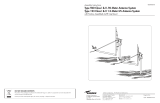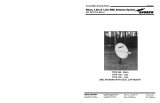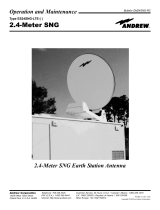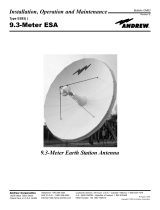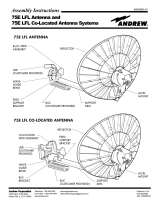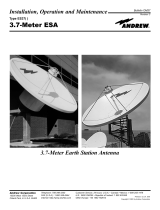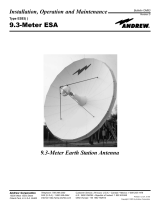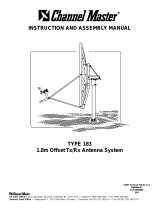Page is loading ...

Assembly Instructions
Type 183
1.8 Meter Transmit Receive Antenna System
Andrew Corporation
3 Westbrook Corporate Center
Suite 900
Westchester, Illinois 60154 USA
Customer Support Center
From North America
Telephone: 1-800-255-1479
Fax: 1-800-349-5444
satcom@andrew.com
International
Telephone: +1-708-873-2307
Fax: +1- 708-349-5444
Internet: www.andrew.com
One Company. A World of Solutions.
Printed in U.S.A.
07/07 8000660-02 Rev B
8000660-02
+
4
0
+
4
0

1
ANDREW CORPORATION
VERY SMALL APERTURE TERMINAL (VSAT) PRODUCTS
TWELVE (12) MONTH LIMITED WARRANTY
Seller warrants that all ANDREW manufactured VSAT products are transferred rightfully and with good title; that they are free from any
lawful security interest or other lien or encumbrance unknown to Buyer. Seller also warrants that for a period of twelve (12) months from
the date of shipment from Seller’s factory, all its VSAT products shall be free from defects in material and workmanship which arise
under proper and normal use and service. Buyer’s exclusive remedy hereunder is limited to Seller’s correction (either at its plant or at
such other place as may be agreed upon between Seller and Buyer) of any such defects by repair or replacement at no cost to Buyer,
except for the costs of any transportation in connection with the return of the defective VSAT products to be replaced or repaired, and
the costs to remove and/or reinstall the products, which shall be borne by Buyer. The limited warranty period shall not be extended
beyond its original term with respect to any part or parts repaired or replaced by seller hereunder.
This warranty shall not apply to VSAT products which (i) have been repaired or altered in any way so as to affect stability or
durability, (ii) have been subject to misuse, negligence or accident, (iii) have been damaged by severe weather conditions such as
excessive wind, ice, storms, lightning, or other natural occurrences beyond Seller’s control; (iv) have presented damages, defects or
nonconformances caused by improper shipping, handling or storage, and (v) have not been installed, operated or maintained in
accordance with Seller’s instructions.
Buyer shall present any claims along with the defective VSAT product(s) to Seller immediately upon failure Non-compliance with any
part of this warranty procedure may invalidate this warranty in whole or in part.
SELLER MAKES NO WARRANTY, EXPRESS OR IMPLIED, OTHER THAN AS SPECIFICALLY STATED ABOVE. EXPRESSLY EXCLUDED
ARE ANY IMPLIED WARRANTIES OF MERCHANTABILITY OR FITNESS FOR A PARTICULAR PURPOSE. THE FOREGOING SHALL
CONSTITUTE ALL OF SELLER’S LIABILITY (EXCEPT AS TO PATENT INFRINGEMENT) WITH RESPECT TO THE VSAT PRODUCTS. IN
NO EVENT SHALL SELLER BE LIABLE FOR ANY LOSS OF PROFITS OR REVENUE, LOSS OF USE, INTERRUPTION OF BUSINESS, OR
INDIRECT, SPECIAL, CONSEQUENTIAL OR INCIDENTAL DAMAGES OF ANY KIND AS A RESULT OF THE USE OF THE
PRODUCTS MANUFACTURED BY SELLER, WHETHER USED IN ACCORDANCE WITH THE INSTRUCTIONS OR NOT. UNDER
NO CIRCUMSTANCES SHALL SELLER’S LIABILITY TO BUYER EXCEED THE ACTUAL SALES PRICE OF THE VSAT PRODUCTS
HEREUNDER.
In some jurisdictions, Buyer may have other rights under certain statutes that may imply non-excludable warranties. No representative is
authorized to assume for Seller any other liability in connection with the VSAT products.
DATE DESCRIPTION REVISION
01/06 9007262 Rev A
07/07 ????????? Rev B
MANUAL REVISION HISTORY
WARRANTY
DO NOT DISCARD CONTENTS
The product in this packaging was placed in the market after August 13, 2005. Its components must not be discarded with
normal municipal or household waste.
Contact your local waste disposal agency for recovery, recycling, or disposal instructions.

LAW: Installation and installer must meet local codes and ordinances regarding
safety! Installation of this product should be performed only by a professional
installer and is not recommended for consumer Do-It-Yourself installations.
DANGER: WATCH FOR WIRES! Installation of this product near power lines is
extremely dangerous and must never be attempted. Installation of this
product near power lines can result in death or serious injury!
For your own safety, you must follow these important safety rules.
Failure to follow these rules could result in death or serious injury!
1. Perform as many functions as possible on the ground
2. Watch out for overhead power lines. Check the distance to the
power lines before starting installation. Stay at least 6 meters (20 feet)
away from all power lines.
3. Do not install antenna or mast assembly on a windy day.
4. If you start to drop antenna or mast assembly, move away from it
and let it fall.
5. If any part of the antenna or mast assembly comes in contact with a
power line, call your local power company. DO NOT TRY TO
REMOVE IT YOURSELF! They will remove it safely.
6. Make sure that the mast assembly is properly grounded.
WARNING: Assembling dish antennas on windy days is extremely dangerous and
must never be attempted. Due to the surface area of the reflector, even
slight winds create strong forces. For example, this antenna facing a
wind of 32 km/h (20 mph) can undergo forces of 269 N (60 lb).
BE PREPARED TO SAFELY HANDLE THESE FORCES AT UNEXPECTED
MOMENTS. ATTEMPTING TO ASSEMBLE, MOVE OR MOUNT A DISH ON
WINDY DAYS COULD RESULT IN DEATH OR SERIOUS INJURY. ANDREW is not
responsible or liable for damage or injury resulting from antenna installations.
WARNING: Antennas improperly installed or installed to an inadequate structure are very
susceptible to wind damage. This damage can be very serious or even life
threatening. The owner and installer assumes full responsibility that the
installation is structurally sound to support all loads (weight, wind and ice)
and properly sealed against leaks. ANDREW will not accept liability for any
damage caused by a satellite system due to the many unknown variable
applications.
WARNINGS
2

3
PRE INSTALLATION CONSIDERATIONS
DESCRIPTION:
The 1.8 Meter Transmit-Receive Antenna System is designed for two-way satellite communications, and is suitable for commer-
cial or consumer use.
TOOLS REQUIRED:
Compass 19 mm or 3/4 in Deep Socket (1/2 in or 13 mm Drive)
Clinometer Ratchet Wrench (1/2 in or 13 mm Drive)
228 mm or 9 in Magnetic Bubble Level 10 mm Nut Driver
Torque Wrench (Capacity 5 - 237 N-m) (4 - 175 ft-lb) 10 mm Box/Open End Wrench
30 mm ( 1.25 in) Adjustable Crescent Wrench 10 mm Socket (For Torque Wrench)
24 mm or 15/16 in Deep Socket (1/2 in or 13 mm Drive) 30 mm Deep Socket (1/2 in or 13 mm Drive)
ADDITIONAL INSTALLATION MATERIALS (Not Included with Antenna)
Grounding Rod, Clamp & Grounding Block - As required by National Electric Code or local codes.
Ground Wire - #10 solid copper or #8 aluminum as required by National Electric Code or local codes (length required).
RG-6 Coaxial Cables from antenna to indoor unit(s).
Concrete: See “Ground Pole” section for quantity
M10 or #3 Rebar: See “Ground Pole” section for quantity. Deformed steel per ASTM A615, Grade 40 or 60.
SITE SELECTION
The first and most important consideration when choosing a prospective antenna site is whether or not the area can provide an
acceptable “look angle” at the satellites. A site with a clear, unobstructed view is preferred. Also consider obstruction that may
occur in the future such as the growth of trees. Your antenna site must be selected in advance so that you will be able to receive
the strongest signal available. To avoid obstructions, etc., conduct an on-site survey with a portable antenna.
As with any other type of construction, a local building permit may be required before installing an antenna. It is the
property owner’s responsibility to obtain any and all permits.
Before any digging is done, information regarding the possibility of underground telephone lines, power lines, storm drains,
etc., in the excavation area should be obtained from the appropriate agency.
Because soils vary widely in composition and load capacity, consult a local professional engineer to determine the appropriate
foundation design and installation procedure. A suggested foundation design with conditions noted is included in this manual
for reference purposes only (see page 4). To assist in the foundation design, refer to “Antenna Wind loads” in the Appendix
“B” on page 11.
BOLT TORQUE
DIN CLASS 5.6 DIN CLASS 8.8
M6 M8 M12 M16 M20 M22 M8 M12 M16
5 N-m 15 N-m 51 N-m 125 N-m 168 N-m 230 N-m 24 N-m 90 N-m 203 N-m
4 ft-lb 11 ft-lb 38 ft-lb 92 ft-lb 24 ft-lb 170 ft-lb 18 ft-lb 66 ft-lb 150 ft-lb
Head marking 5.6 or 8.8, if no head marking use DIN Class 5.6 values in above chart.
EXCEPTIONS TO ABOVE CHART:
• M12 x 100 mm round head square neck bolts securing antenna to mount. Torque to 27 N-m (20 ft-lb).
• M12 x 130 mm hex head bolts securing feed support to backframe tube. Torque to 47 N-m (35 ft-lb).

114 mm
(4.5” O.D.)
1270 mm
(50”)
1410 mm
(55.5”)
1270 mm
(50”)
Antenna
Center Line
9.5 x 254 mm
(#3 x 10”) rebar
diameter of pier.
Insert through
hole in tube and
center.
#3 Rebar
D
Minimum
Diameter
25 mm
to 51 mm
(1” to 2”) slope
for water run-off
Grade
Below
Frost Line
Pier Foundations
25 mm
to 51 mm
(1” to 2”) slope
for water run-off
Grade
D
Minimum
Diameter
Below
Frost Line
Approx.
51 mm
(2”)
1676 mm
(66”) (See Note)
#3 rebar x diameter
of pier
Insert through
hole in tube and center.
#3 Rebar
#3 rebar x .6 m (24”)
at 60˚ apart (See note)
( Six Places)
51 mm (2”)
Bubble
Level
Ground Pole Must Be
Vertical in All Directions
at Top
NOTE:
1.7 m (66”)
may be
increased.
Concrete
and length
of rebar will
increase
accordingly.
Deep Frost Line Foundations
Bottom View
WIND VELOCITY DIMENSION D CONC VOLUME DIMENSION D CONC VOLUME GROUND POLE
mm (Inches) Cubic Meter (CUYD) mm (Inches) Cubic Meter (CUYD)
100 mph 762 (30) .61 (.80) 610 (24) .54 (.70) A
125 mph 934 (37) .91 (1.2) 762 (30) .76 (1.0) B
POLE SPECIFICATIONS:
Ground Pole “A”- 4.50 O.D. SCH 40 (4.026 I.D.) Steel - (Metric = 114.3 mm x 102.3 mm I.D.)
Ground Pole “B”- 4.50 O.D. SCH 80 (3.826 I.D.) Steel - (Metric = 114.3 mm x 97.2 mm I.D.)
NOTE:
1. Poles are not supplied (purchased locally to ASTM A501) and must be field drilled 5/8 diameter for M10 #3 rebar, drilled
5.55 mm (.218”) for 1/4-20 self tapping grounding screw and galvanized or painted for protection.
2. Pole and foundation design based on the following criteria:
a. Uniform building code Exposure C and 1.5 stability factory.
b. Vertical soil pressure of 2000 pounds per square foot. (9765 Kilograms/meter square)
c. Lateral soil pressure of 300 pounds per square foot. (1465 Kilograms/meter square)
d. Concrete compressive strength of 2500 pounds per square inch (176 Kg/cm
2
) in 28 days.
CAUTION: The foundation design shown does not represent an appropriate design for any specific locality, since soil
conditions vary and may not meet design criteria given in Note 2. You should consult a local professional engineer to
determine your soil conditions and appropriate foundation.
GROUND POLE INSTALLATION (114 mm or 4.50 in OD)
4
2438 mm
(96”)
424 mm
(16.7”)
1270 mm
(50”)
2438 mm
(96”)
114 mm
(4.5” O.D.)

5
ASSEMBLY AND INSTALLATION
Backframe Tube
Assemble bottom tube (14) to
backframe (28) with four M12 x 19 mm
hex bolts (29), as shown.
Torque to 47-54 N-m (35-40 ft-lb).
28
14
29
4 Places
Yoke Cap Assembly
Place yoke cap assembly (25) onto ground
pole. Assemble channel and assembly to
yoke cap assembly with (4) M12 x 35 mm
round head square neck (Item 27), flat
washers and hex nuts (5 & 26) as shown.
Loosen trunnion bolts. Secure azimuth
adjusting bolt (23) to yoke cap assembly
with M12 x 30 mm hex bolt, lock washer
and hex nut (4, 5 & 10).
M12 x 35 mm
Round Square Neck Bolt
with Flat Washer
Lock Washer
and Hex Nut
(4 Places)
M12 x 30 mm
Hex Head Bolt
with Hex Nut and
Lock Washer
Azimuth
Adjustment Screw
M12 x 35 mm
Round Square Neck
Pivot Bolt with
Lock Washer
and Hex Nut
M12 x 35 mm
Pivot Bolt
M12 x 35 mm
(4 Places)
Partial End View
21
27
10
23
25
26
5
4
5
8
22
(4 Places)
(4 Places)
(4 Places)
Ground
Pole

6
Yoke Cap and Backframe Assembly
Point yoke cap assembly south and temporarily secure to ground pole with locking bolts. Push M12 x 35 mm round head
square neck pivot bolt through center square hole in cap top plate and attach channel assembly. Secure with M12 hex nut and
lock washer. Torque to 11-15 N-m (8-11 ft-lb). Assemble bottom tube (14) to backframe (28) as shown. Torque M12 x 19 mm
special bolt (29) to 47-54 N-m (35-40 ft-lb). Install backframe assembly onto yoke cap assembly.Secure with M20 x 140 mm
hex bolt and hex nut (9 & 11). Loosen M12 hex bolt (10) and remove one M22 hex nut (7) from elevation adjsting screw (6)
and insert into trunnion (8). Trunnion (8) in position shown is for 12˚ and above elevation. If elevation is less than 13˚, pivot
trunnion 180 degrees. Reinstall M22 hex nut (7). Do not tighten. Run up M22 hex nuts (7) on elevation screw (6) and place
backframe in birdbath position.
Antenna Installation
Insert four M12 x 100 mm round head square neck bolts (1) into reflector (2) and place reflector onto backframe. Secure
reflector to backframe with four M12 lock washers and hex nuts (4 & 5). Tighten and torque to 27 N-m (20 ft-lb). Torque
cross arm bolts (12) 4 places to 58 N-m (40-45 ft-lb).
IMPORTANT: “UP” arrow on reflector must be as shown. Make sure round head square neck bolts are seated correctly be-
fore securing reflector to backframe. Pre-torque (4) M12 x 35 m round head square neck bolts (Item 27) to 12 N-m (8-10 ft-lb).
Yoke Cap
Assembly
10
Ground Pole
Locking
Bolts
SOUTH
6 7
8
9
11
14 28
Back Frame
5
4
2
1
UP
4 Places
26
14
17
3
4
16
17
3
Back View
of Yoke Cap

15
16
17
15
19
14
19
5
13
12
13
17
16
17
18
20
3
3
18
17
19
*Torque to 58 N-m (43 ft-lb)
**Torque to 5.4 N-m (4 ft-lb)
7
Feed Support Tube
Install M6 x 40 mm hex bolt (15) with flat washer (16) into bottom hole in reflector rim (2) and secure with M6 flat washer and
M6 hex nut (16 & 17). (Refer to Figure 1.1)
IMPORTANT:
M6 x 40mm hex bolt (15) in bottom of reflector rim, fits into hole on top of support tube lower end for
positioning.
Assemble feed support tube (19) onto backframe and secure with two M12 x 130 mm hex bolts (12) with M12 tooth lock
washer. (13)
NOTE: M12 tooth washer (13) must be assembled on bolts (12), with one under head of bolts and one under hex nuts (4).
(Refer to Figure 1.2) Leave these bolts loose.
Swing reflector down by loosening nuts (7) on elevation screw (6). When reflector is in a convenient position, (approximately
20 degrees), snug tighten nuts on elevation screw.
Install left and right side struts (20) onto reflector as shown in Figure 1.3. Attach long formed end of side strut (20) to reflector
rim by inserting M6 x 20 mm hex bolt (3) thru inside of rim and secure snug, but free to pivot with M6 lock washer and hex nut
(18 & 17). Attach short formed end of side struts (20) to feed support tube using M6 x 20 mm hex bolt, lock washer and hex
nut (3, 18, 17).
IMPORTANT: Without using excessive pressure, lift feed support tube vertically, just enough to relieve all loads off side struts,
while another person tightens and torques M12 hex bolts (*) securing feed support tube to backframe to
47 N-m (35 ft-lb) and M6 hex head bolts (**) securing side struts to reflector to 5.4 N-m (4 ft-lb).
(Refer to Figure 1.4)
Install feed/feed horn per instructions provided with these items.

6.3 mm (1/4 in) - 20 UNC
x 15.8 mm (5/8 in)
Type D Point Hex Head
Tapping Screw
8
NOTE: All installations to conform to the latest issue of the National Electric Code and local codes.
6.3 mm (1/4 in)
External Tooth
Lock Washer
Ground
Lug
GROUNDING INSTRUCTION FOR GROUND POLE
Ground
Pole
Ground Wire Typical
(#10 AWG Copper, #8
Aluminum) Refer to NEC
Section 810 and Local
Electric Codes For The
Specific Area Requirements.
Drill Hole Through
One Wall of Tube
with 5.5 mm (7/32 in)
Twist Drill and Apply
Sealant After Assembly
to Prevent Corrosion.
Coaxial Cable
To Receiver
(Not Supplied)
Ground Block
NEC Section 810-20
(Not Supplied)
Ground Wire
NEC Section 810-20
(Not Supplied)
Coaxial Cable
From LNB
(Not Supplied)
NOTE: All installations to
conform to latest issue of
National Electrical Code.
Ground antenna mount
assembly and feed cables
in accordance with current
National Electrical code
and local codes.
These illustrations depict
typical grounding methods
for the ground pole and
feed cables. Clamps that
provide a solid connection
between ground wire and
ground source should be
used. Tighten and torque
all hardware.
Cable Grounding Components
Are Not Supplied

9
ANTENNA ALIGNMENT PROCEDURE
Satellite Alignment
Alignment with the satellite is obtained by setting polarization, elevation, and azimuth. Charts are provided on page 11, 12
and 13 to determine the values for your earth station antenna site. “∆L” is the difference between the earth station antenna site
longitude and the satellite longitude. Use “∆L” and your earth station latitude to obtain polarization, elevation or azimuth
setting.
Polarization of Feed
Loosen feed horn clamp bolts and turn feed clockwise
or counter clockwise, depending on being east or west
of the satellite as shown in Polarization Chart on page
11. Align marks on the horn clamp and appropriate
mark on the horn scale. Polarization chart assumes
antenna system polarization is transmit vertical and
satellite vertical Pol is perpendicular to plane of
geostationary arc. For horizontal transmit of antenna,
feed must be rotated 90˚ from values shown. (Starting
point for polarization adjustment is 0˚).
Elevation Alignment
Use Elevation Chart on page 12 and determine
your elevation setting. Using a clinometer, adjust
the elevation by turning the elevation screw
adjusting nuts until the desired elevation is
obtained.
Note: Degree values shown on the clinometer
are mechanical. When the reflector face is
vertical, mechanical elevation is 90˚ or axis
is 0˚, while the beam elevation (signal) axis
is 22.62˚. Therefore, as the reflector is tilted,
remember to compensate for the 22.62˚ offset
angle to get the correct beam elevation. (See
Appendix A, Outline Drawing, Page 18). This is
an approximate setting. Optimum setting will be
achieved during the fine tuning.
Loosen
Elevation
Bolt
Elevation
Adjustment
Screw
Trunnion
Clinometer
Elevation
Hex Nuts
Loosen
Pivot Bolt
Rib
Horn
Scale
Alignment
Mark
Clamp
Bolt

Fine Tuning
Progressively tighten and torque azimuth locking bolts to 100-115 N-m (75-85 ft-lb). The four top plate locking bolts are
pre-torqued to 11-15 N-m (8-11 ft-lb). Maintain this torque until after azimuth is fine tuned.
Use a signal strength measuring device for final adjustments to obtain maximum antenna performance. Alternate between
elevation and azimuth fine tuning to reach maximum signal strength, until no improvement can be detected. Gradually tighten
(1/8 turn increments max.) top plate bolts in sequence 1st, 2nd, 3rd and 4th to 100 N-m (75 ft-lb). Observe for maximum
signal strength as elevation screws M22 locking nuts are tightened.
Polarization tune may be checked by slowly rotating feed assembly in clamp. When maximum signal strength is found,
gradually tighten clamp bolts. If a signal on the opposite polarity is available, this signal should be minimized.
Tighten and torque all hardware. Refer to Torque Chart on Page 3.
10
Azimuth
Use Azimuth Chart on page 13 and
determine your azimuth setting. Values
in chart must be adjusted for magnetic
deviation for your location for correct
compass reading.
Equally tighten the six azimuth
locking bolts until snug. This will
allow the reflector to rotate with slight
resistance.
Rotate reflector and mount, pointing to
the compass reading for your location.
Slowly sweep the reflector in azimuth
until signal is found. If desired signal is
not found, increase or decrease
elevation setting and repeat the
azimuth sweep. Tighten locking bolts.
Top Plate
Pivot Bolt
Azimuth
Locking Bolts
(6 Places)
Turn Nuts
Clockwise
or Counter
Clockwise For
Azimuth Fine
Tuning
Azimuth
Adjustment
Screw
Top Plate
Locking
Bolt
(4 Places)
1st
4th
2nd
3rd
Rotate Antenna
On Ground Tube
Azimuth
Example Depicts Azimuth Heading To 171˚
(Azimuth ± Magnetic Deviation)
Compass

11
POLARIZATION CHART
EARTH STATION LATITUDE IN DEGREES NORTH OR SOUTH OF EQUATOR
FEED ROTATION
(Facing Antenna)
For + Polarization Rotate Counter Clockwise
For - Polarization Rotate Clockwise
Antenna
Polarization Chart Sign Values (+ or -) Northern Hemisphere Southern Hemisphere
Antenna Site West of Satellite Longitude - +
Antenna Site East of Satellite Longitude + -
Feed

12
ELEVATION CHART
Use of Elevation Chart
n Determine = the difference between your site longitude and the satellite
longitude.
n Find you latitude on horizontal axis.
n Follow your latitude up until you intersect the curve for your .
n Read Elevation value on vertical axis.
ELEVATION IN DEGREES

13
“ “ IS THE DIFFERENCE BETWEEN THE EARTH STATION
ANTENNA SITE LONGITUDE AND THE SATELLITE LONGITUDE
EARTH STATION ANTENNA AZIMUTH IN DEGREES
EARTH STATION ANTENNA AZIMUTH IN DEGREES
EARTH STATION ANTENNA LATITUDE IN DEGREES NORTH OR SOUTH OF EQUATOR
AZIMUTH COLUMN READING WHEN EARTH STATION IS WEST OF SATELLITE
AZIMUTH COLUMN READING WHEN EARTH STATION IS EAST OF SATELLITE
AZIMUTH CHART

10
11
12
13
14
16
17
18
19
2
3
4
5
6
7
1
8
9
15
14
PARTS LIST
NO. DESCRIPTION QTY.
1 M12 x 100 mm Carriage Head Bolt 4
2 1.8 Meter Reflector 1
3 M6 x 20 mm Stainless Steel Hex Head Bolt 4
4 M12 Stainless Steel Lock Washer 13
5 M12 Galvanized Hex Nut 16
6 Galvanized Elevation Adjustment Screw 1
7 M22 Galvanized Hex Nut 2
8 Trunnion 1
9 M20 x 140 mm Galvanized Hex Head Bolt 1
10 M12 x 30 mm Galvanized Hex Head Bolt 8
11 M20 Galvanized Hex Nut 1
12 M12 x 130 mm Galvanized Hex Head Bolt 2
13 M12 External Tooth Lock Washer 4
14 Bottom Backframe Tube 1
15 M6 x 40 mm Stainless Steel Hex Head Bolt 1
NO. DESCRIPTION QTY.
16 M6 Stainless Steel Flat Washer 2
17 M6 Stainless Steel Hex Nut 5
18 M6 Lock Washer 4
19 Feed Support Tube Weldment 1
20 Side Feed Support Strut 2
21 Top Yoke Plate Weldment 1
22 Channel 2
23 M16 Azimuth Adjustment Bolt 1
24 M16 Galvanized Hex Nut 2
25 Yoke Cap Weldment 1
26 M12 Flat Washer 4
27 M12 x 35 mm Round Head Square Neck Bolt 5
28 Backframe Weldment 1
29 M12 x 19 mm Galvanized Special Hex Head Bolt 4
20
25
26
27
28
29
17
18
17
16
5
4
7
4
3
13
10
5
10
5
4
10
21
22
23 24

15
MAINTENANCE
To ensure that the transmit/receive mount and 1.8 m SMC Offset Antenna is operating efficiently and at an optimum,
moderate maintenance is required. We recommend conducting as routine maintenance inspection every six months or as
needed, if unusual circumstances occur, such as severe weather conditions, falling objects and vandalism.
The following checklist is provided for your convenience.
MAINTENANCE INSPECTION CHECKLIST
1 FOUNDATION
Structural Damage
2 TRANSMIT RECEIVE MOUNT
All bolts (if any loosening has occurred tighten and torque - refer to Torque Chart Page 3)
Structural Damage
Corrosion of galvanized steel members (if necessary, repair with cold zinc-rich galvanizing paint)
3 1.8 METER SMC OFFSET ANTENNA
Bolts - M12 round head square neck, securing antenna to mount (Correct torque 27 N-m/20 ft-lb)
Structural Damage
4 BOTTOM FEED SUPPORT TUBE, SIDE FEED SUPPORT STRUTS AND ORU BRACKET
All bolts (if loosening has occurred tighten and torque - refer to Torque Chart on Page 3).
Structural Damage
Corrosion of galvanized steel members (if necessary, repair with cold zinc-rich galvanizing paint)
5 FEED ASSEMBLY
All securing hardware
Structural Damage
Feed Horn Weather Cover - Physical Damage (if damaged, replace to prevent entry of water)
Upon inspection, make necessary repairs and replace any damaged parts. For replacement parts, contact
ANDREW CORPORATION at the address located on the front of this manual.

16
HARDWARE SORTER
Galvanized M20 x 140 mm
Hex Head Pivot Bolt
Item 9
Galvanized M12 x 100 mm
Round Head Square Neck Bolt
Item 1
Galvanized M12 x 30 mm
Class 8.8 Hex Head Bolt
Item 10
M16 x 20 mm Stainless Steel
Hex Head Cap Screw
Item 3
Galvanized M12 x 19 mm
Hex Head Bolt
Item 29
M6 x 40 mm Stainless Steel
Hex Head Cap Screw
Item 15
Galvanized M12 x 130 mm
Class 8.8 Hex Head Bolt
Item 12
All hardware is depicted actual size. Place hardware on picture to verify identity.

APPENDIX A
17
+
4
0
+
4
0
+
4
0
+
4
0
9˚
Beam Axis
Antenna Mech Axis
22.6˚
34 cm
(13.4 in)
158.1 cm
(62.2 in)
99.2 cm
(39.1 in)
22.6˚
Beam Axis
Antenna Mech Axis
44.6 cm
(17.6 in)
35.1 cm
(13.8 in)
195.7 cm
(771 in)
140.7 cm
(55.4 in)
197.2 cm
(77.6 in)
197.2 cm
(77.6 in)
182.2 cm
(71.7 in)
114.3 mm
(4.5 in O.D.)
Type 183 1.8 Meter Offset Receive Transmit Antenna System

Elevation Force Moments
Degrees Pounds* Foot-Pounds*
Mechanical Beam F
H
F
V
M
T
M
O
0 23 1,824) -47 1,073 8,436
10 33 1,726 -365 1,035 7,983
20 43 1,677 -710 984 7,756
30 53 1,519 -1,008 892 7,025
40 63 1,337 -1,215 756 6,184
50 73 1,166 --1,337 635 5,393
60 83 972 -1,398 491 4,496
70 93 729 -1,082 378 3,372
APPENDIX B
F
H
= Horizontal Force
F
V
= Vertical Force
M
T
= Torsional Moment
M
O
= Overturning Moment
M
T
F
V
M
O
F
H
18
+
4
0
+
4
0
22.6˚
Beam Axis
44.6 cm
(17.6 in)
35.1 cm
(13.8 in)
140.7 cm
(55.4 in)
197.2 cm
(77.6 in)
Antenna Mechanical Axis
(Normal to Reflector)
Mo Based on 55” (140.7 cm) From Mounting Surface to CL of Antenna.
*Kg = Pounds x .45359
**N-m = Foot-Pounds x 1.35582
Values shown above represent maximum forces for any wind direction.
Height and exposure factors from the uniform building code are NOT included.
/

